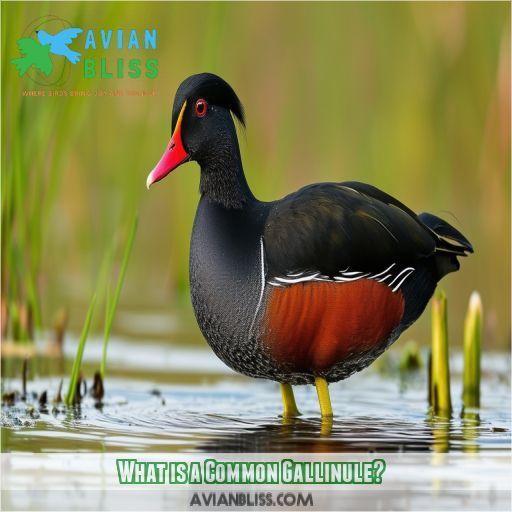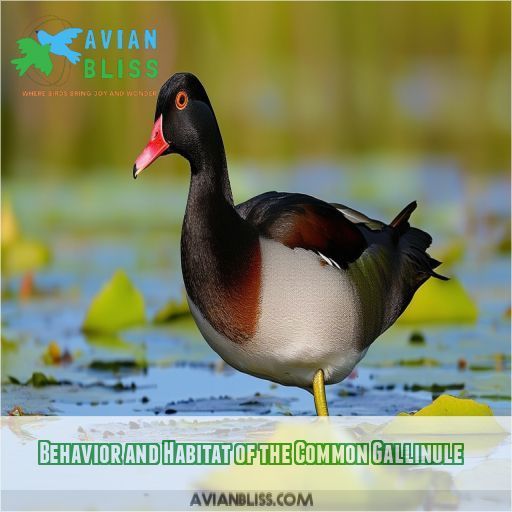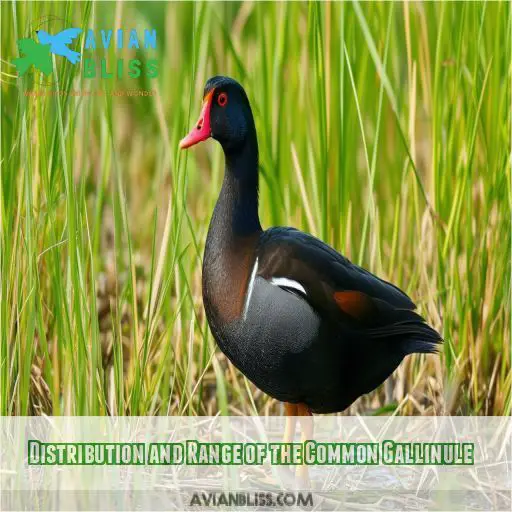This site is supported by our readers. We may earn a commission, at no cost to you, if you purchase through links.

This bird is quite the character, with its loud "kuk-kuk-kuk" call and territorial antics. It prefers shallow marshes and ponds with dense, floating vegetation.
Regarding nesting, both parents share the duties, caring for 8-11 buff-colored eggs with brown spots.
Want to dive deeper into their fascinating world? There’s plenty more to uncover!
Table Of Contents
- Key Takeaways
- What is a Common Gallinule?
- Physical Characteristics of the Common Gallinule
- Behavior and Habitat of the Common Gallinule
- Distribution and Range of the Common Gallinule
- Nesting and Reproduction of the Common Gallinule
- Diet and Feeding Habits of the Common Gallinule
- Frequently Asked Questions (FAQs)
- Is a Common Gallinule the same as a moorhen?
- Is a Common Gallinule a duck?
- Where are common gallinules found?
- Are Gallinules good to eat?
- How long do Common Gallinules live?
- Are there any threats to Common Gallinules?
- How do Common Gallinules communicate?
- Do Common Gallinules migrate seasonally?
- What predators do Common Gallinules face?
- Conclusion
Key Takeaways
- Dive into the fascinating world of the Common Gallinule, a striking marsh bird with a vibrant red bill and a distinctive black head and neck.
- Discover their unique foraging techniques, from swimming with wings raised to diving for food, showcasing their adaptability in their watery habitat.
- Witness their territorial nature and loud "kuk-kuk-kuk" calls, as they fiercely defend their space in the marsh ecosystem.
- Learn about their nesting behavior, where both parents share the responsibility of incubating their buff-colored eggs, ensuring the survival of their young.
What is a Common Gallinule?
The Common Gallinule is a medium-sized marsh bird in the rail family, previously known as the Common Moorhen. It’s characterized by its dark slate-gray body, black head and neck, and a distinctive red bill with a yellow tip.
A Medium-sized Marsh Bird in the Rail Family
The Common Gallinule, part of the rail family, is a medium-sized marsh bird known for:
- Courtship rituals
- Foraging strategies
- Territorial behavior
- Thriving in emergent marsh vegetation
- Scientific names: Gallinula chloropus and Gallinula galeata
You’d often find these birds traversing shallow waters, displaying their striking slate-gray bodies and distinctive red bills with a yellow tip.
Formerly Called the Common Moorhen
The Common Gallinule, formerly known as the Common Moorhen, underwent reclassification due to molecular studies by the American Ornithologists’ Union. This change helped clarify its relationship with other duck-like birds. Despite varying population trends, its conservation status remains stable. Common in cultural tales, they’re recognized for their striking dark bodies and unique markings.
| Aspect | Details | |
|---|---|---|
| Classification History | Reclassified by AOU | |
| Bodies | Dark Slate-Gray | |
| Significance | Cultural Tales | |
| Status | Stable |
Physical Characteristics of the Common Gallinule
The Common Gallinule boasts dark slate-gray feathers with a striking black head and neck. Its distinctive red bill with a yellow tip, coupled with white undertail coverts and greenish-yellow legs, make it easily recognizable in its marshy habitat.
Dark Slate-gray Body With Black Head and Neck
The Common Gallinule, also known as the Purple Gallinule (Porphyrio martinica), sports a dark slate-gray body, complementing its striking black head and neck. These vivid contrasts make it stand out in marsh habitats.
- Dark slate body
- Black head
- Black neck
- Red bill with a yellow tip
- White undertail coverts
This combination is truly eye-catching against the dense vegetation.
Red Bill With Yellow Tip
The Common Gallinule‘s striking red bill with a yellow tip is one of its most distinctive features. This red-orange bill, with its vibrant yellow tip, serves important functions, including tip wear resistance and aiding in foraging. Additionally, during the nesting season, this coloration intensifies, making the birds more noticeable in marshes throughout the eastern half of the country.
White Undertail Coverts
The Common Gallinule’s white undertail coverts are a distinctive feature, easily visible during its swimming technique and territorial behavior. These coverts, contrasting with the bird’s dark slate-gray body, play an integral role during visual scans in coastal plain marsh habitats. Look for the bright white undertail, bordered by white flank stripes, as it moves through grassy vegetation.
Greenish-yellow Legs and Feet
The Common Gallinule stands out with its distinct greenish-yellow legs and feet. This unique coloration aids its movement on floating vegetation often found in habitats like the Great Lakes marsh. These agile legs help it forage and maintain balance. This striking feature complements its dark plumage and is easily noted during calm observations or call playback sessions.
Behavior and Habitat of the Common Gallinule
Common gallinules forage in shallow water by swimming with their wings held up or walk on land with their long, slender toes. They’re territorial and aggressive, defending their territory with a loud "kuk-kuk-kuk" call.
Forages in Shallow Water or on Land
When foraging, the Common Gallinule exhibits fascinating behaviors:
- Swimming Behavior: Frequently seen swimming, often with wings partially raised.
- Foraging Strategy: Dips its head underwater or walks atop floating vegetation to find food.
- Habitat Preferences: Favors shallow marshes, swamps, and ponds with dense vegetation, providing both cover and ample foraging opportunities, enhancing its survival.
Territorial and Aggressive, With a Loud kuk-kuk-kuk Call
During the breeding season, Common Gallinules become highly territorial and aggressive, often loudly proclaiming their presence with a distinctive, raspy "kuk-kuk-kuk" call. This behavior safeguards nesting success by deterring rivals. Unfortunately, population trends are threatened by habitat loss, raising conservation concerns. Preserving marshes and swamps is critical for these birds’ survival and continued thriving.
Distribution and Range of the Common Gallinule
Moving from behavior and habitat, let’s delve into the distribution and range of the Common Gallinule. These birds are widespread across the Americas, stretching from Canada down to Chile. You’ll often find them inhabiting marshes, swamps, and ponds where thick vegetation meets open water. Their range suits their need for dense cover and floating vegetation to forage and nest.
While largely sedentary in tropical regions, northern populations migrate south to avoid harsh winters. Despite their broad range, habitat loss threatens local populations. Conservation efforts focus on preserving wetland environments to maintain their habitats. Spotting these boldly marked rails alongside American Coots emphasizes their adaptability and resilience despite environmental pressures.
Nesting and Reproduction of the Common Gallinule
The common gallinule lays 8-11 buff-colored eggs with brown spots, and both parents incubate the eggs for 19-22 days.
Lays 8-11 Buff-colored Eggs With Brown Spots
Common Gallinules are dedicated parents. You’ll find them nesting in thick vegetation. They lay 8-11 buff-colored eggs adorned with irregular brown spots. Their courtship behavior includes chasing, bowing, and mutual preening. Nests are crafted from cattails, bulrushes, or reeds, often featuring a ramp leading to the water, ensuring their omnivorous young stay safe.
Both Parents Incubate the Eggs for 19-22 Days
Both parents participate in incubating the eggs, a process lasting between 19-22 days. During the breeding season, courtship rituals include the male chasing the female and both preening each other’s feathers. They build nests using various nesting materials like cattails and bulrushes. Parental care is extensive, with hatchling development supported by both parents.
Key Points:
- Incubation lasts 19-22 days
- Both parents participate
- Nests are made from local vegetation
- Extensive parental care
Diet and Feeding Habits of the Common Gallinule
The Common Gallinule showcases remarkable omnivorous behavior, diligently foraging in diverse ways. You’ll often see these adaptable birds foraging while swimming, walking, or even climbing through vegetation. Its diet variety includes leaves, stems, seeds, fruits, berries, insects, spiders, earthworms, snails, tadpoles, and carrion.
Employing unique foraging techniques, they may dip their heads underwater, up-end while swimming, or occasionally dive. The competition for food is fierce in their habitat, pushing Gallinules to be resourceful. They’ll even scavenge carrion, showcasing their adaptability.
With such a varied diet, they play a pivotal role in their ecosystem, ensuring nutrient cycling and balance. Their eating habits are a fascinating mix of instinct and adaptability, ensuring their survival in diverse environments.
Frequently Asked Questions (FAQs)
Is a Common Gallinule the same as a moorhen?
Yes, a Common Gallinule is the same as a moorhen. Imagine this vibrant bird forging ahead through marshes—it’s known for its dark slate-gray body, red bill, and the striking white racing stripe down its side.
Is a Common Gallinule a duck?
No, a Common Gallinule isn’t a duck. It’s a marsh bird related to rails and moorhens. With a dark gray body, red bill, and yellow-tipped feet, it swims but shows distinct physical and behavioral traits.
Where are common gallinules found?
You can find these birds in marshes, swamps, and ponds with dense vegetation and open water, spanning from Canada to Chile in North and South America, often alongside American Coots.
Are Gallinules good to eat?
You can eat Gallinules, but they’re not commonly sought after for their meat. Their diet and habitat can lead to a gamey taste that mightn’t appeal to everyone. Always verify proper preparation and cooking.
How long do Common Gallinules live?
Common Gallinules typically live around 3-4 years in the wild, though some individuals can reach up to 9 years. Life expectancy is influenced by factors like predation, habitat quality, and environmental conditions.
Are there any threats to Common Gallinules?
Imagine a marsh shrinking due to urban expansion. Common Gallinules face threats like habitat loss, pollution, and predation from invasive species. Pollution affects their food sources and breeding grounds, making survival a challenge.
How do Common Gallinules communicate?
You’ll hear Common Gallinules communicate with a mix of loud, raspy "kuk-kuk-kuk" calls, squawks, and whinnies from thick cover. Their vocalizations are essential for territory defense and maintaining contact within their dense marsh habitats.
Do Common Gallinules migrate seasonally?
About 90% of Common Gallinules in the northern United States migrate seasonally to South America. You’ll find them moving between marshes, ponds, and dense vegetation, following warmer climates for ideal foraging and nesting.
What predators do Common Gallinules face?
You’ll find Common Gallinules facing predators like raccoons, snakes, snapping turtles, and large birds of prey such as hawks and owls. These predators mainly target eggs, chicks, and sometimes adult gallinules in marshes and ponds.
Conclusion
But what truly sets the Common Gallinule apart?
This adaptable bird, with its distinctive physical traits and unique behaviors, showcases resilience in various habitats.
You’ll find it foraging in shallow waters, aggressively defending territory, and caring for its brood of buff-colored eggs.
With its broad range and adaptable diet, the Common Gallinule is a fascinating study in avian survival and ecology.
Explore more and appreciate the intricate world of this marsh bird.









